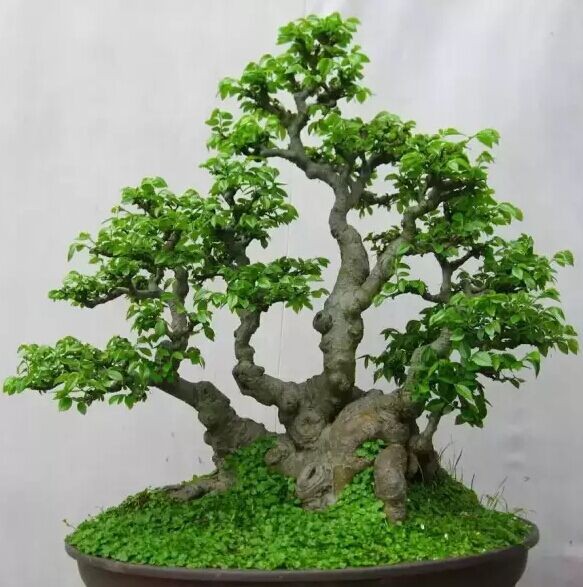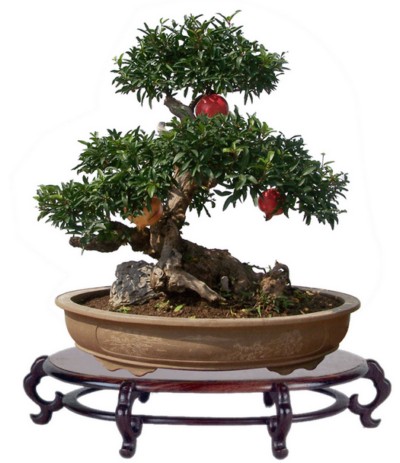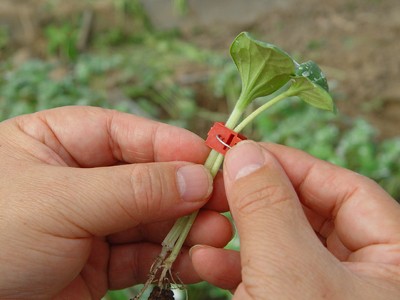Pruning of elm bonsai
Deciduous trees, up to 25 m tall and 1 m DBH, growing into shrubs in dry land; young trees with smooth, grayish brown or grayish bark, dark gray, irregularly deeply lobed, rough; branchlets glabrous or hairy, yellowish gray, light brownish gray or gray, light brownish yellow or yellow, with scattered lenticels, no inflated cork layer and protruding cork wings Winter buds subglobose or ovoid, bud scales abaxially glabrous, margin of inner bud scales white villous.

Leaves elliptic-ovate, long-ovate, elliptic-lanceolate or ovate-lanceolate, 2-8 cm long and 1.2-3.5 cm wide, apex acuminate or long acuminate, base oblique or nearly symmetrical, one side cuneate to round, the other round to semi-heart-shaped, leaf surface smooth glabrous, dorsal pubescent when young, later glabrous or part of vein axil clustered hairy, margin doubly serrate or simple serrate, lateral veins 9-16 on each side Petiole 4-10 mm long, usually only pubescent above. Flowers first leaves open, clustered in axils of branches.
Samara suborbicular, sparsely Obovate-orbicular, 1.2-2 cm long, glabrous except for apical notched stigma indumentum, the rest is glabrous, the kernel is located in the middle of Samara, the upper end is not close to or close to the notch, its color is the same as fruit wing before and after maturity, light green, later white-yellow, persistent perianth glabrous, 4-lobed, lobes margin hairy, fruiting pedicel shorter than perianth, 1-2 mm longer, indumentum (or sparsely) pubescent. The flowering and fruiting period is from March to June (later in the northeast).
Trim:
The purpose of pruning is to create a beautiful tree shape, that is, to leave branches in the right place for styling. In general, the dead, diseased and weak branches of the tree should be cut off first, and then the overgrown branches, cross branches, parallel branches, reverse branches, central branches, radiation branches, opposite branches and vertical branches that interfere with the shape of the tree should be cut off.
The cut should be smooth to facilitate healing. There are usually no residual branches when pruning. The basic shape is generally only controlled pruning the pointed branches and leaves to keep the body beautiful.
The twigs should not be pruned too often in the growing season. Winter is the best time for pruning, when the leaves fall, and the structure of the branches inside the crown is clear. Pruning can eliminate the disadvantages, improve the shape, and help to concentrate nutrients to make the retained branches grow better in the coming spring. After years of pruning, the bonsai shape will be gradually perfect.
Elm trees, especially the old piles that grow in the wild, have gradually formed many different strange gestures after years of man-made chopping axe chisels, or wind and rain erosion, animal bites and so on. Some are intertwined, vigorous and simple, while others turn decay into magic, withered roots and new leaves, unique caves, and are excellent materials for making bonsai.
Time: 2019-06-13 Click:
- Prev

The shape of pomegranate bonsai
Pomegranates like fertilizer, planting when the bottom of the pot to put a few pieces of animal hooves and a small amount of decomposed bean cake as base fertilizer. Pomegranates are adaptable and lax in soil requirements. They can grow in acidic or alkaline soil. The soil is loose and fertile, but they are afraid of waterlogging. Planting pomegranate bonsai
- Next

Cutting Seedling technique of potted Osmanthus fragrans
Osmanthus fragrans are ornamental flowers and fragrant trees which are special products of our country. They are evergreen all the year round, blossom in autumn and fragrant. This film is from the aspects of growth characteristics, environmental requirements, variety selection, cutting seedling technology, seedling management, young tree transplanting, young and adult tree management, sweet-scented osmanthus harvest and so on.
Related
- Fuxing push coffee new agricultural production and marketing class: lack of small-scale processing plants
- Jujube rice field leisure farm deep ploughing Yilan for five years to create a space for organic food and play
- Nongyu Farm-A trial of organic papaya for brave women with advanced technology
- Four points for attention in the prevention and control of diseases and insect pests of edible fungi
- How to add nutrient solution to Edible Fungi
- Is there any good way to control edible fungus mites?
- Open Inoculation Technology of Edible Fungi
- Is there any clever way to use fertilizer for edible fungus in winter?
- What agents are used to kill the pathogens of edible fungi in the mushroom shed?
- Rapid drying of Edible Fungi

